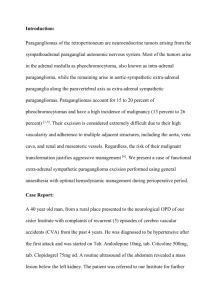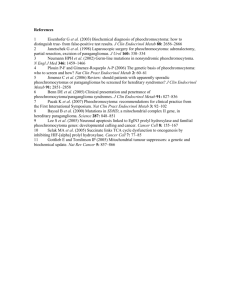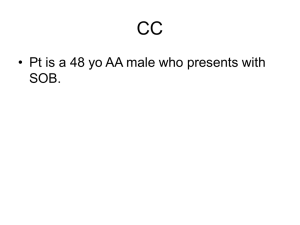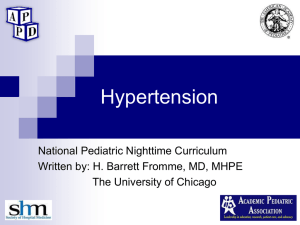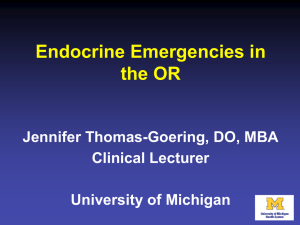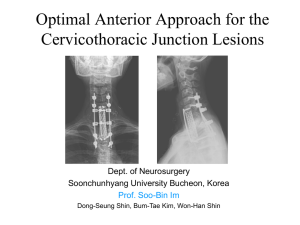Blurred vision as a presenting feature in a suprarenal pediatric
advertisement
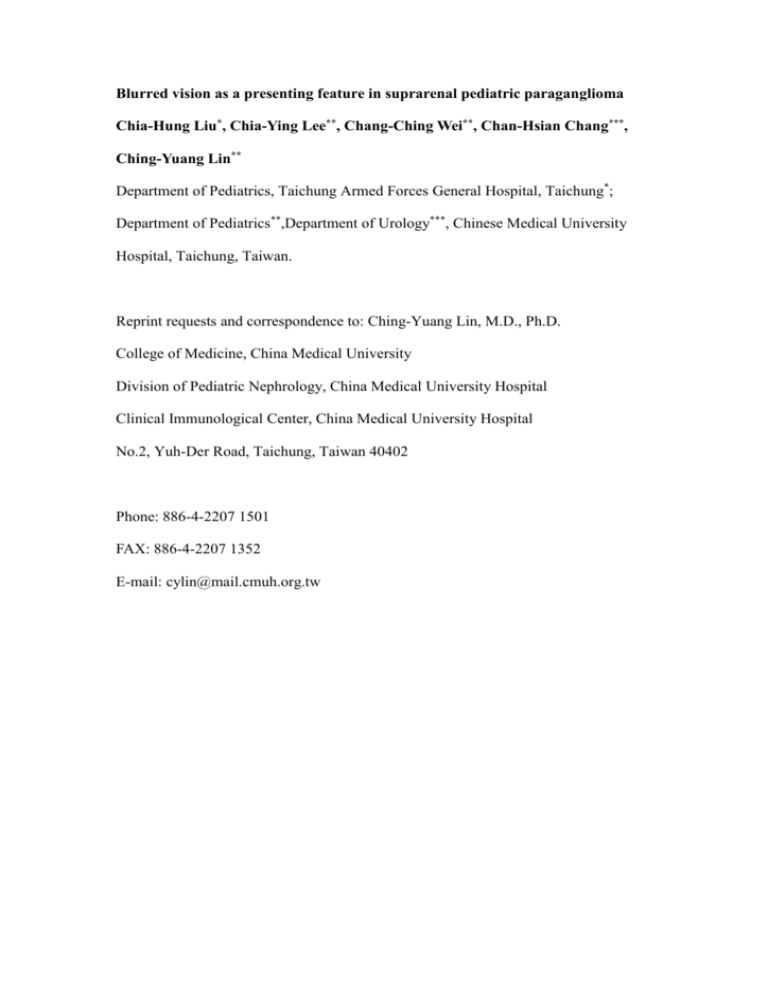
Blurred vision as a presenting feature in suprarenal pediatric paraganglioma Chia-Hung Liu*, Chia-Ying Lee**, Chang-Ching Wei**, Chan-Hsian Chang***, Ching-Yuang Lin** Department of Pediatrics, Taichung Armed Forces General Hospital, Taichung*; Department of Pediatrics**,Department of Urology***, Chinese Medical University Hospital, Taichung, Taiwan. Reprint requests and correspondence to: Ching-Yuang Lin, M.D., Ph.D. College of Medicine, China Medical University Division of Pediatric Nephrology, China Medical University Hospital Clinical Immunological Center, China Medical University Hospital No.2, Yuh-Der Road, Taichung, Taiwan 40402 Phone: 886-4-2207 1501 FAX: 886-4-2207 1352 E-mail: cylin@mail.cmuh.org.tw Abstract Ocular manifestations of hypertensive retinopathy such as vision impairment or even loss associated with pheochromocytoma were reported. Here we report a case of a fifteen-year-old girl with bilateral blurred vision for two months; her past medical history was unremarkable. Initial blood pressure (BP) was 218/159 mm Hg. Ophthalmoscopy showed bilateral hypertensive retinopathy with optic disc edema. Two-dimensional echocardiography revealed hypertrophy of the interventricular septum and left ventricular wall. Initial emergent hypertension was stabilized with phenoxybenzamine and calcium channel blocker. Renal ultrasound and abdominal computed tomography revealed a huge right suprarenal tumor with compressing renal hilar vessels. Urinary vanillymandelic acid (VMA) level was 56.5 mg/24 hr (normal, 2-7 mg/24 hr). Retroperitoneal suprarenal paraganglioma was highly suspected. Tumor resection was arranged after blood pressure had stabilized for two weeks. Pathological study revealed a 10x6.7x4 cm paraganglioma and potential of metastasis. Postoperative 18-fluorodeoxyglucose positron emission tomography scan revealed no metastasis. Her visual acuity, BP and VMA level returned to normal after tumor resection. While pediatric pheochromocytoma incidence is rare, blurred vision with hypertensive retinopathy may be induced by pheochromocytoma/paraganglioma in children. We thought it worthwhile to report our experience with a patient who initially presented blurred vision from paraganglioma. Key Words: Paraganglioma, Hypertensive retinopathy, Vanillymandelic acid INTRODUCTION Pheochromocytomas in children, arising from chromaffin cells of adrenal medullary or extra-adrenal paraganglionic tissue, are rare. Incidence of pheochromocytoma and paraganglioma is 0.40-2.06 per million per year.1-2 Most cases are found in adults, less 2 than 5% in children.3 Most symptoms are due to elevated levels of catecholamines. Sustained hypertension in pediatric pheochromocytoma cases is more common than in adult cases. Pheochromocytoma is estimated to be prevalent in approximately 1% of hypertensive pediatric patients and should be considered after exclusion of more common causes.4-5 Paroxysmal hypertension or development of orthostatic hypotension against the background of sustained hypertension or amelioration or even inversion of circadian BP rhythm may be crucial to finding pheochromocytoma.6 Palpitations, headache, excess sweating and pallor are well-known symptoms of continuous or paroxysmal catecholamine excess and should arouse suspicion of pheochromocytoma.7 Sweating, nausea, vomiting, weight loss, polyuria and visual disturbances are reported more often in children than in adults.8-9 While pediatric pheochromocytoma and paraganglioma is a rare disease, it is an important differential diagnosis for childhood hypertension. Ocular manifestations of hypertensive retinopathy such as vision impairment or loss associated with pheochromocytoma were reported. CASE REPORT A fifteen-year-old girl visited our outpatient clinic because of a two-month history of blurred vision. Excessive sweating was also noted for three years. Her medical history was unremarkable, family history negative for hypertension. Hypertensive retinopathy was suspected at ophthalmologic clinic when she was admitted for further observation. Her body weight was 51.8 kg (50th percentile), body height 158cm (50-75th percentile), visual acuity 0.05 in both eyes. Slit lamp examination and intraocular pressure were normal. Ophthalmoscopic examination showed papilledema over optic disc; hemorrhage and cotton-wool spots at retina in each eye. Heart rate was 122 beats/minute, respiration rate was 20/minute. Wide fluctuations in BP were noted: 3 maximal systolic and diastolic BP of 218 mm Hg and 159 mm Hg to minimal systolic and diastolic BP of 150 mm Hg and 110 mm Hg, respectively. Auscultation revealed grade 2 short systolic murmurs over left middle sternal border, no palpable abdominal mass, urinalysis negative. Complete cell count, blood urea nitrogen, creatinine, and electrolyte levels of blood were within normal limits. Urinary VMA level was 56.5 mg/24 hr (normal 2-7 mg/24 hr), plasma renin activity 9.62 ng/mL/hr during supine (normal 0.15-2.33 ng/mL/hr). Chest roentgenography and electrocardiography tested normal. Two-dimensional echocardiography revealed hypertrophy of interventricular septum and left ventricular free wall. Ultrasound and computed tomography of the abdomen demonstrated a right retroperitoneal, suprarenal tumor with size of 7.2 x 5.5cm. Before operation, right retroperitoneal, suprarenal paraganglioma was suspected. The patient was treated with phenoxybenzamine, an alpha-adrenergic blocking agent and calcium channel blocker. Initial phenoxybenzamine dosage was 30 mg/day, increased to 120 mg/day after 4 weeks of therapy to control systolic BP within the range 130 to 100 mm Hg. Surgery was arranged after hypertension was controlled. Tumor resection was arranged after BP had stabilized for two weeks. A 10x6.7x4 cm tumor located between aorta and inferior vena cava with much collateral circulation and dense adhesion were noted intraoperatively. Microscopically, tumor mass is encapsulated and the tumor cells within the mass were characterized by round and focal pleomorphic nuclei, indistinct to small nucleoli, and pink cytoplasm (Fig. 1a). Tumor cells were arranged in nest or Zellballen pattern (Fig. 1b). Tumor nests were surrounded by thin fibrovascular channels. Both vascular and capsular invasion with patchy hemorrhage and confluent necrosis were noted. Nerve bundles both within and at the periphery of tumor mass were also noted. Several big vessels within tumor mass and vascular wall were invaded by tumor cells focally. There was no 4 adrenal component in this specimen. Immunohistochemical study showed tumor cells were positive stain for synaptophysin (Fig. 1c) and chromogranin (Fig. 1d). Sustanticular frameworks were highlighted by S-100 (Fig. 1e). All section margins were free, but tumor nests were very close to section margins focally (less than 1mm). Potential of malignancy and metastasis was highly suspected, with tumor necrosis, capsular invasion, vascular invasion and large vessels within tumor mass with invaded vascular wall observed. Ki-67 positive cells were about 4-5%. Paraganglioma with potential of metastasis was diagnosed. Postoperative 18-fluorodeoxyglucose positron emission tomography scan revealed no metastasis. Visual acuity, BP and VMA level normalized after tumor resection and were monitored constantly in outpatient clinic. DISCUSSION Pheochromocytoma, originating from chromaffin cells of adrenal medullary or extra-adrenal paraganglionic tissue, is rare in children. When these arise from the autonomic nervous system of abdomen, thorax, neck or head, they are more specifically termed paragangliomas but often referred to as extra-adrenal pheochromocytomas. While pheochromocytoma and paraganglioma in childhood are rare, they represent the most common pediatric endocrine tumor and are a key cause of severe hypertension in children. Clinical presentation of childhood pheochromocytoma is highly variable, with tumors found in some patients who are completely asymptomatic. Average age at onset was 11 years, with a male/female ratio of 2:1.5, 10 Hypertension as the most prominent features, and may be paroxysmal or persistent. It is caused by secretion of one or more catecholamine hormones. Compared with adults, children more often present symptoms related to hypertension: headache, tachycardia, diaphoresis, postural hypotension, nausea, vomiting, abdominal or chest pain, weight loss, shortness of breath, polydipsia, polyuria, 5 acrocyanosis, convulsions, and visual disturbances. 11 Yet symptoms and signs of pheochromocytoma are not specific in children; early diagnosis is not easy. Clinical alertness and BP measurement are vital for detecting child hypertension. Sustained hypertension is found in 60-90% of pheochromocytoma in pediatric cases, versus 50% of adult cases. Pheochromocytoma should be considered after excluding usual causes of pediatric hypertension. Evaluation of suspected pheochromocytoma should include 24-hour norepinephrine, epinephrine, total metanephrines, and VMA concentrations in urine. In more than 95% of patients, diagnosis can be established by increased urinary VMA concentration.12 Plasma catecholamine determination is generally less useful than urinary assessment, except in hypertension crisis. Upon diagnosis, surgical excision is the only curative treatment. Surgical complications may emanate from excessive and abrupt release of catecholamines.12 Adequate preoperative preparation and treatment with non-competitive alpha-adrenoreceptor blocker like phenoxybenzamine can treat adrenergic manifestations and hypertensive crisis during anesthetic induction or surgical manipulation of tumors as well as reduce morbidity and mortality effectively. Patients with adequate phenoxybenzamine are prone to orthostatic hypotension.13 This preoperative treatment should be given in the hospital; patients should be instructed on need for and assisted in maintaining upright position to prevent complications. Hypertensive retinopathy is uncommon and a critical condition for children. Delay diagnosis result in permanent visual damage owing to optic atrophy. In early stages, fundus picture shows retinal arteriolar constriction. As the disease progresses, superficial hemorrhages and small white superficial foci of retinal ischemia in nerve fiber layer (cotton-wool spots) develop. In severe hypertension, optic discs become congested and edematous. If elevated BP is controlled promptly with medication or 6 surgery, retinal blood vessels may recover without permanent pathologic changes.14 In our patient, fundus ophthalmoscopy revealed intraretinal hemorrhage, cotton-wool spots and optic disc edema; visual acuity dramatically returned to normal after tumor resection, indicating early correction may reverse hypertensive retinopathy in a child. Though pediatric pheochromocytoma and paraganglioma are rare, blurred vision with hypertensive retinopathy may arise from either. Permanent visual damage can be a severe complication without early treatment; 24-hour urine VMA, plasma catecholamine and localized image study can aid diagnosis. Preoperative stabilization of BP and surgical intervention resulted in uneventful recovery. In sum, pheochromocytomas have varied clinical ocular manifestation of blurred vision and hypertensive retinopathy. While pediatric pheochromocytoma is rare, it is a key diagnosis for child hypertension. References 1. Fernandez-Calvet L, Garcia-Mayor RV: Incidence of pheochromocytoma in South Galicia, Spain. J Intern Med 1994; 236:675-677. 2. DeGraeff J, Horak BJ: The incidence of pheochromocytoma in the Netherlands. Acta Med Scand 1964; 176:583-593. 3. Abramson SJ: Adrenal neoplasms in children. Radiol Clin North Am 1997; 35:1415-1453. 4. Ein SH, Shandling B, Wesson D, Filler R: Recurrent pheochromocytomas in children. J Pediatr Surg 1990; 25:1063-1065 5. Ross JH: Pheochromocytoma. Special considerations in children. Urol Clin North Am 2000; 27:393-402 6. Zelinka T, Pacak K, Widimsky J Jr: Characteristics of blood pressure in pheochromocytoma. Ann NY Acad Sci 2006; 1073:86-93 7 7. Lenders JW, Eisenhofer G, Mannelli M, Pacak K: Phaeochromocytoma. Lancet 2005; 366:665-675 8. Ciftci AO, Tanyel FC, Senocak ME, Buyukpamukcu N: Pheochromocytoma in children. J Pediatr Surg 2001; 36:447-452 9. Hack HA: The perioperative management of children with phaeochromocytoma. Paediatr Anaesth 2000; 10:463-476 10. Beltsevich DG, Kuznetsov NS, Kazaryan AM, Lysenko MA: Pheochromocytoma surgery: epidemiologic peculiarities in children. World J Surg 2004; 28:592-596 11. Werbel SS, Ober KP: Pheochromocytoma: update on diagnosis, localization, and management. Med Clin North Am 1995; 79:131-153. 12. Barvo EL: Evolving concepts in pathophysiology, diagnosis, and treatment of pheochromocytoma. Endocr Rev 1994; 15:356-368. 13. Russell WJ, Metcalfe IR, Tonkin AL, et al: The preoperative management of pheochromocytoma. Anaesth Intensive Care 1998; 26:196-200. 14. Tso MO, Jampol LM: Pathophysiology of hypertensive retinopathy. Ophthalmology 1982; 89:1132-1145. 8 Figure of Legend Figure1. Hematoxylin and eosin stain demonstrating tumor cells characterized by round and focal pleomorphic nuclei (1a) and arranged in nest or Zellballen pattern (1b). Immunohistochemical stain showed tumor cells were positive for synaptophysin (1c) and chromogranin (1d). Also, sustanticular frameworks highlighted by S-100 (1e). 9 Fiq 1a Fiq 1b Fiq 1c Fiq 1d 10 Fiq 1e 11 以視力模糊作表現之兒科腎外嗜鉻細胞瘤 嗜鉻細胞瘤之病患以高血壓視網膜病變造成視力障礙作為最初之臨 床症狀,迄今國內十分罕見。我們報導一例十五歲女性出現兩個月視 力模糊,過去病史無特殊異常,其血壓為218/159毫米汞柱。眼底檢 查呈現雙眼高血壓視網膜病變合併視神經盤水腫;經眼科轉介小兒 科,發現心臟超音波呈現左心室肥厚。高血壓急症經降血壓藥 phenoxybenzamine和鈣離子阻斷劑治療逐漸血壓控制穩定。腎臟超音 波及腹部電腦斷層掃描發現右腎上方一巨大腫瘤併腎血管壓迫。尿中 二十四小時vanillymandelic acid (VMA)是56.5 mg (正常值每日2-7 mg);疑似 後腹腔腎上方之腎外嗜鉻細胞瘤。於血壓穩定兩週後實施腫瘤切除 術;術後病理報告為一10x6.7x4公分之腎外嗜鉻細胞瘤疑似併有轉 移。術後實施正子攝影顯示尚未出現轉移。病患視力及血壓在術後均 恢復正常。嗜鉻細胞瘤在兒童十分罕見;但高血壓視網膜病變造成視 力模糊在兒科其中一個可能原因是由嗜鉻細胞瘤引起。故我們認為值 得提出此病例報導。 12
